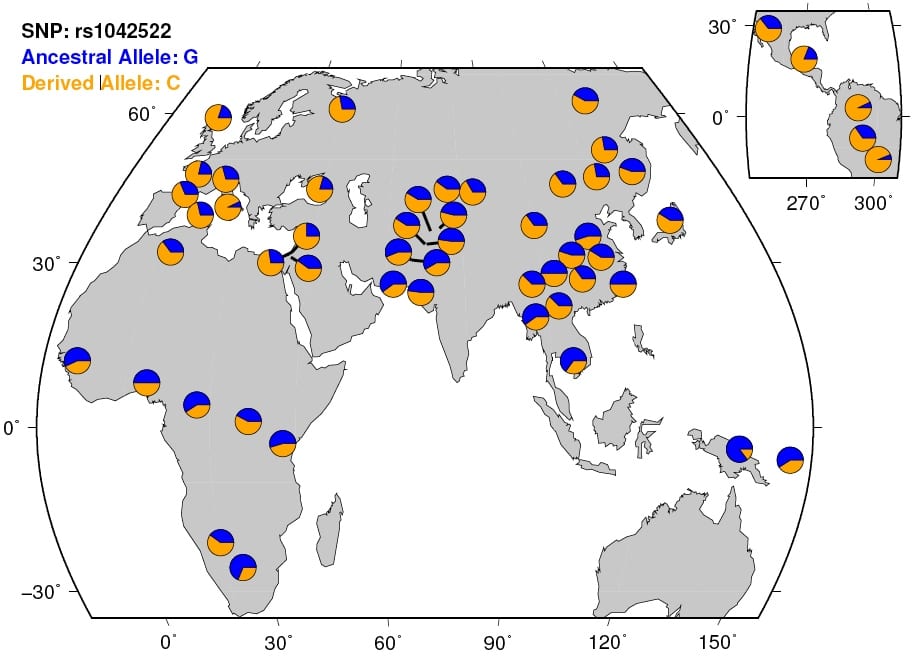
How can geneticists tell when a genetic difference between two human populations is an accident and when it’s the result of natural selection?
As our species moved out of Africa and spread out across the globe, there were a lot of chances for random DNA mutations to occur. Many of these were neutral — they didn’t help or hurt a person’s chances for survival or reproduction — and whether they stuck around in a population’s gene pool was just a matter of luck. But some of these mutations actually helped people deal with the environmental changes and challenges they were facing. These advantageous mutations tended to build up in frequency over the generations as they enhanced the reproductive success of the people who inherited them.
In some cases, there’s a satisfyingly simple story that demonstrates how a random mutation led to an advantage. The version of the lactase gene that confers lactose tolerance, for example, is much more common in people of European ancestry than those with African or Asian ancestry. This fits with the fact that about 8,000 years ago some of the world’s first dairy farmers emerged in — you guessed it — Europe. For these people, the ability to digest milk would clearly have been a boon.
But some genetic differences between populations haven’t been so straightforward to explain. For example, one version of a variation in the p53 gene is found at higher levels in people with European ancestry than in those with African ancestry. Is this just a matter of chance, or was there a reason this version of the gene increased in frequency as people moved north?
The best guess scientists have had so far is that the genetic difference has something to do with latitude and, by extension, exposure to UV radiation from the sun. It’s certainly a plausible explanation. The p53 gene helps protect cells from cancer, and UV radiation is known to be mutagenic. But almost any difference between European and African populations would correlate with latitude, so that doesn’t prove anything.
In a study published online last week in the American Journal of Human Genetics, a group of researchers analyzed this p53 variation in Asian populations that are closely related genetically (at least compared to European vs. African populations), but nonetheless live at very different latitudes. Their results were somewhat surprising. The p53 variation does vary with latitude, but it’s not correlated with UV radiation level. Instead, it’s how cold it gets in the winter that seems to matter.
Researchers analyzed rs1042522 in 4,029 people from 67 populations located throughout eastern Asia, from 11 ° south of the equator (Indonesia) to 65 ° north (northern China). They found that the C version of this SNP is more common at higher latitudes, as was expected based on the work in European and African populations.
The amount of UV radiation a locale receives, however, showed no correlation with the frequency of the C version of the SNP. Instead, it was chillier winter temperatures that seemed to translate into more people in the population having the C version of rs1042522.

But why would the C version of rs1042522 be advantageous in colder climates? Like so many genetic adaptations, it may all come down to making babies.
Using previous research about p53 as their guide, the authors of the study tested the ability of different forms of the p53 gene — containing either a C or a G at rs1042522 — to activate LIF, a gene important for embryo implantation in the womb, at different temperatures.
The results of these experiments indicate that the C version of the p53 gene is better at activating LIF in the cold. This suggests that as populations moved into colder climates, those people with the C version of rs1042522 might have had an easier time conceiving (and therefore would have left behind more offspring, who in turn would pass the C version of the SNP on to their children).
But can a colder climate really bring down conception rates? The parents of “blizzard babies” might disagree, but the authors point out that in cattle at least, cold temperatures have been shown to have an effect.
Bonus:
The researchers also looked at rs2279744, a variation in the MDM2 gene that (like rs1042522 in p53) is found at different frequencies in different populations. The MDM2 variation did not vary with latitude or temperature, but did correlate with UV radiation levels. Populations with higher UV radiation exposures had higher frequencies of the G version of rs2279744.
The MDM2 gene encodes a protein that reduces cellular levels of the p53 tumor suppressor protein. The G version of rs2279744 leads to higher levels of MDM2 protein, and thus lowers levels of p53. The researchers speculate that as people moved out of Africa and into Asia, the lower levels of DNA-damaging UV light meant they could afford to have less p53 in their cells. Because lower p53 levels are better for embryonic development, the scientists think nature would have favored the G version of rs2279744.
Bonus Bonus:
Do p53 and MDM2 sound familiar? Last week the Blog covered recent reports linking rs1042522 to colorectal cancer survival in African Americans and rs2279744 in MDM2 to melanoma risk in young women.
Map of rs1042522 frequencies is from the HGDP Selection Browser.